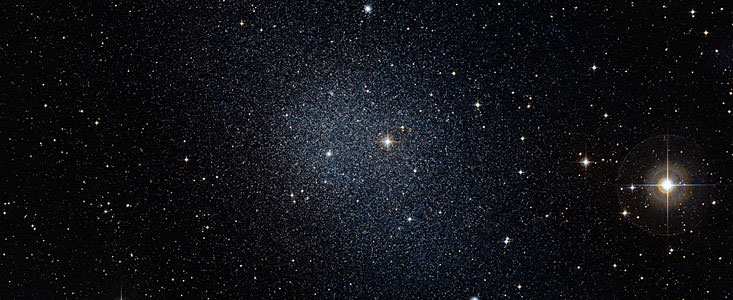Universe Today | Jon Voisey | 2011 Aug 10
There are some places astronomers dare not tread. One of the prime places is beyond the disk of our own galaxy where the numerous stars and clouds of dust along the line of sight make observations messy to say the least. This obscured portion of the sky is known as the Zone of Avoidance. But despite the challenges, one team of astronomers has searched through it and found a previously undiscovered galaxy lurking not too far from our own.
To discover this galaxy, the team, lead by graduate student Travis McIntyre at the University of New Mexico, used the gigantic Arecibo radio telescope. This telescope is adept at finding emission at the 21 centimeter wavelength emitted by cool, atomic hydrogen. This long wavelength is relatively immune to the diminishing effects of gas and dust within our galaxy.
After the initial discovery, the team followed up with further observation using the Expanded Very Large Array (EVLA), which also operates in the radio, as well as the 0.9 meter Southeastern Association for Research in Astronomy telescope, which is an optical telescope, in hopes of peering through some of the muck.
While the galaxy was easily recovered in the second radio search, and the optical images showed a faint clump, the centers of the two did not appear to line up. The visual and radio components seemed not to overlap almost at all. A portion of the reason for this is that the team was unable to image the faint galaxy out to its full extent before the contamination from our own galaxy overwhelmed the signal. As such, the two likely overlap more than is indicated by the study, but this would still indicate that the distribution of hydrogen gas within it is severely lopsided.
Another possibility is that the object detected isn’t really a galaxy at all and is a coincidence of an alignment between a high velocity cloud and an independent cluster of stars. However, such clouds of gas tend to travel in packs and no others are known in the area, making this possibility unlikely.
If the object is a galaxy, it is likely a blue dwarf galaxy with some 10 million solar masses. The team expects that, while the galaxy is relatively nearby, this galaxy is not likely to bea member of the local group because, were it that close, it would be unprecedentedly small. As such, they applied Hubble’s Law to give a rough distance of 22 million light years but caution that at such distances, there is a large velocity dispersion and this estimate may be unreliable.
Searching for galaxies like this one in the Zone of Avoidance are important to astronomers because the mass of such undiscovered galaxies may help to resolve the unexpected “discrepancy between the cosmic microwave background dipole and what is expected from gravitational acceleration imparted on the Local Group by matter in the local universe.”
Discovery and Follow-up of a Nearby Galaxy from the Arecibo Zone of Avoidance Survey - T McIntyre et al
- arXiv.org > astro-ph > arXiv:1107.4343 > 21 Jul 2011
